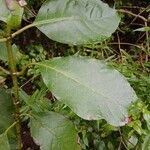Shrub or tree up to 6 m. tall; branches and branchlets spreading, stout, glab. Lvs opp. on rather stout petioles ± 10-20 mm. long. Stipules connate towards base, obtuse, glab., crowned by 1-2 prominent sharp denticles. Lamina coriac., dullish dark green above, paler below, glab.; elliptic to elliptic-oblong to broad-ovate, acute or obtuse, ± mucronate, gradually narrowed to petiole, ± 7-12 × 3-4-(5) cm.; reticulated veins us. conspicuous on both surfaces. ♂ in axillary many-fld glomerules on short peduncles, glomerules again divided into dense clusters. Calyx-teeth minute; corolla subcampanulate, lobes triangular, acute, < tube. ♀ in compound clusters on trichotomously branched axillary peduncles 10-15 mm. long. Calyx minute, truncate, sts with 1-2 teeth; corolla c. 5 mm. long, narrow-funnelform, lobes acute or obtuse, oblong-triangular, < tube. Drupe dark orange to yellow, oblong to narrow-ovoid, 8-9 × 4-5 mm.
More
A shrub. It grows 3.5 m high. The branches are stout and spreading. The leaves are less glossy than Coprosma repens. They are leathery and shiny green but with a colourless border which has fine hairs. The flowers are greenish-yellow and in dense clusters. The fruit are orange-red berries.
Lowland forest and shrubland, especially on alluvial soils. Found from sea level to 1200 metres, it is often found where the soil is poor or swampy or where conditions are windy or cold.
More
It is a warm temperate to subtropical plant. It grows on the edge of forests and hillsides. It suits hardiness zones 8-11. Tasmania Herbarium. Arboretum Tasmania.




